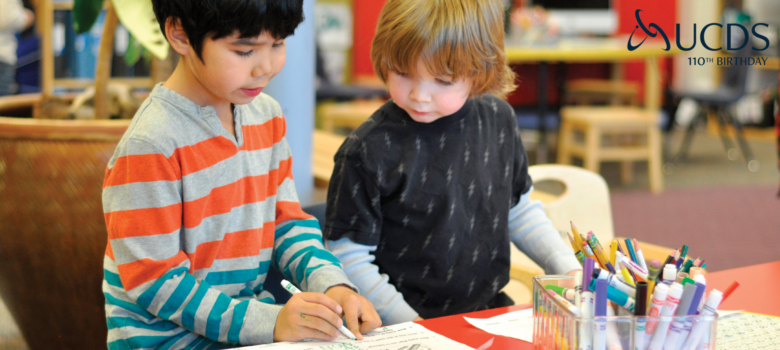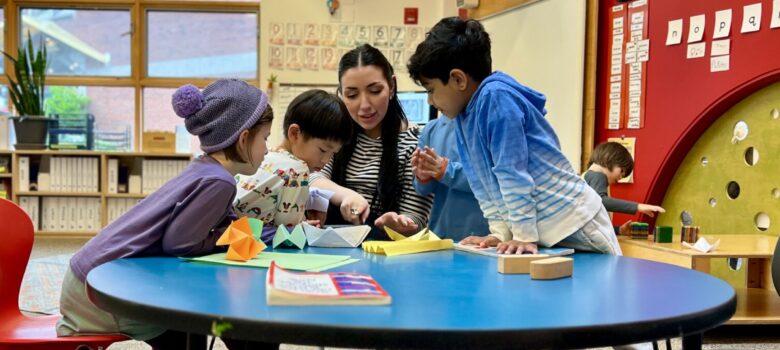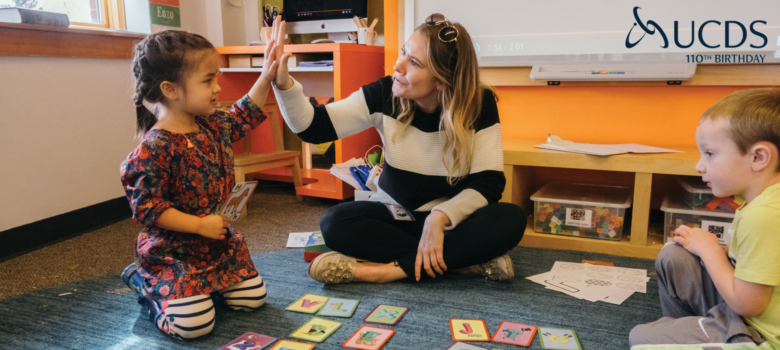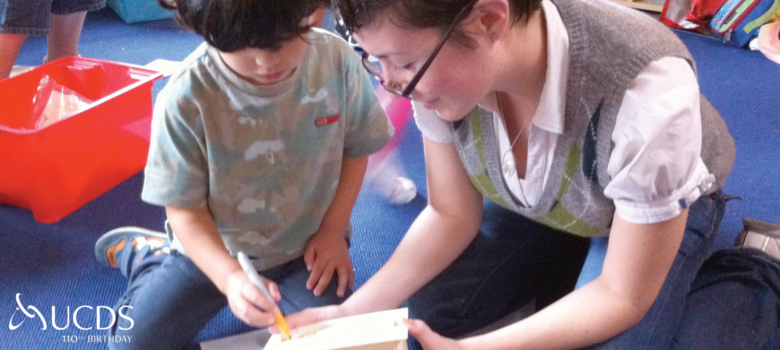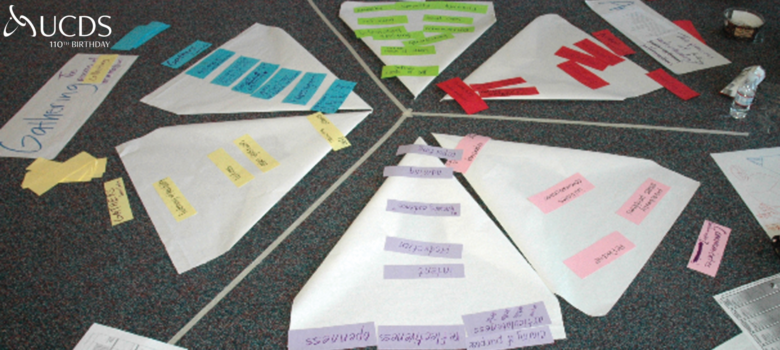UCDS is having a birthday! As we celebrate our 110th year, we are rolling back the clock and re-sharing six highlights of an innovative school: Culture of Inquiry, Sticky Curriculum, Authentic Assessment, Teacher Mentorship through Collaboration, Coaching Independence, and Being Brave. Over the next six weeks, we’ll revisit some in-depth reflections from UCDS Spark Magazine. You can also read full archived content of Spark Magazine at: https://issuu.com/ucds
I Made Fire! Teachers Coach Independence,
One-on-One
by Susan Foley and Sally Minerich
UCDS Spark
Issue #14, Fall 2014
Combining red, yellow and orange swirls of color, Jack, a four year old in an Early Elementary classroom shares, “I made fire coming out of the volcano. The dinosaur lives near the volcano.” With his illustration complete, he finds a teacher and announces, “My word today is dinosaur. I’m ready for writing!” His teacher takes a moment to acknowledge and discuss Jack’s independence exhibited through his picture and word choice, and she passes him a pencil, “You get started writing dinosaur and I’ll be over soon!” Jack’s questioning eyes express some hesitation. Up until now, the writing has always been done with a teacher by his side guiding his practice in letter sounds and formation and assisting him in separating the words into distinct sounds. As Jack’s writing skills develop, the role of the teacher as a guide adapts. Thus, he has been given the challenge to try writing some letters independently. As he slowly reaches for the pencil, the teacher confidently reminds him that he needs simply to take his best guess and write any letters he thinks are in the word dinosaur. He looks around the table and notices that indeed, some classmates are writing before the teacher comes over to help. He says the word dinosaur aloud a few times and announces his plan to start by writing a D.
In this multi-age classroom, there is a wide range of experience, knowledge and abilities. The writing assignments for each student reflect this. Whether drawing a picture, sharing an idea or writing a few letters, words, or sentences, each student is asked to begin in a place where he or she feels confident and can be successful. Drawing on their own understanding, students are given the opportunity to try things independently to demonstrate what they already know. They are also asked to take a risk on trying something new or not yet solidified independently before their work with a teacher begins. Teachers routinely assess individuals and tailor assignments to include personal challenges that fit each student. They guide each student to build on current skills by coaching him or her through individualized next steps. A student’s initial attempt or approach is an important way that a teacher may assess and determine what challenges make sense for a particular student. The practice of starting with what you know or giving something a try also sends a powerful message to children that education is not about discrete lessons or facts, rather it is about making connections and decisions about how to apply the knowledge and skills you already have to gain deeper understandings and new insights.
This philosophy is a driving force at UCDS as teachers guide and encourage children, whether working through academic or social challenges and whether in pre-K or in 5th grade preparing for middle school. Classroom teachers and specialists are equally committed to following this model and creating curriculum that provides many opportunities for a variety of entry points and challenges. Additionally at UCDS, teachers have great respect for the enthusiasm and determination children have for learning and are committed to modeling the same curiosity. Teachers become active participants in learning. This provides opportunities for teachers to model thinking through a problem. Free from the constraints of teaching a set curriculum based on age or grade level, teachers are invested in making the most out of their time with students.
Teachers ask many questions under this model. “What have you tried?” “How did it go?” “What might work instead or next?” Learning is viewed as a continuous process, where putting to use the skills you have already acquired allows you to move forward, building on past knowledge and understanding is essential to growth. Students are given opportunities to devise strategies to solve problems, and teachers guide them to navigate their own thinking as well as make suggestions and offer possible solutions to try. Successes and missteps are celebrated and examined for the lessons they provide. With guidance and encouragement from teachers, students are asked to work hard and take responsibility for their learning. If a solution comes easily, teachers see that as an ideal opportunity to pose a new challenge. Students are taught to reflect on and modify strategies as they work through more difficult problems. They practice perseverance, learn from mistakes, and in turn build creative and critical thinking skills.
With independence also comes the understanding that not everyone will approach a problem in the same way. Students learn to expect that peers at the same table could be working on a variety of problems and at a variety of skill levels. They also learn to expect that even when they work on the exact same problem, they will likely approach it differently and have a different process for solving it. Opportunities to share strategies give students important practice in explaining their thinking, and as students consider novel ways of solving problems, they build flexibility in their thinking.
From their first day at school, students are actively engaged in their social learning and problem solving. Just like the student who inquires about the spelling of a word, the student who gets help to solve a disagreement with a friend will hear similar questions, “What have you tried?” “How did that work?” “Are there any strategies that have helped you in the past?” “What do you think you could try next?” As teachers ask guiding questions such as these, the students are learning self-talk and internalizing the kinds of questions they can ask themselves as new situations occur. As novel situations arise, children can draw on these conversations to guide their responses and develop skills that allow them to be independent thinkers and question askers.
Students cannot learn problem solving and negotiating skills without taking an active role in this process. They benefit from practice forming questions that move the learning or problem solving process forward, and using a variety of problem solving skills in a hands-on and meaningful way is essential. What is meaningful is different based on the student.. Some students rely on more teacher modeling and direction than others, and some relish puzzling through tricky problems while others are supported by gradual challenges with more frequent teacher check-ins. Teachers adapt to each student’s style while keeping key elements consistent. When a student is a part of the process, adding his or her skills and knowledge to the conversation, he or she is able to think and reflect and then practice new skills with ever increasing independence.
The implications of fostering this independence are great, even for seemingly simple tasks. For example, in a 2nd-3rd grade classroom, students are getting ready for their next activity. The teacher reminds her class to check the schedule so each small group will know if they are going from Science to PE and then to lunch or the reverse (PE to Science and then to lunch). This prompts some to question if it makes sense to bring their lunchboxes with them, to save a trip back to class. The teacher turns the question back on the group, and there is a healthy debate among students based on the locations of the different classes and what makes the most sense, saving time versus managing belongings. In the end it is decided that consensus need not be reached and everyone can find the solution makes sense for him or her, give it a try and modify next time if desired.
Even this small interaction has provided an opportunity for independent thought and decision-making, ownership over an action and the potential to modify. Under this model, students are increasingly accountable and aware of their individual needs, learning styles, strengths and challenges. They also learn how to advocate for themselves when they need support and learn to celebrate mistakes as part of the learning process. Students’ understanding of mistakes, or unknowns, as a part of learning, is exemplified every year in our science lab. Katie Morrison, our science teacher focuses on scientific practice skills, including making a prediction or hypothesis. She highlights to students that sometimes experiments result in evidence to support your hypothesis, but sometimes they do not and if something unexpected happens in an experiment, we can celebrate it as a discovery. Katie explains, “When I first started teaching, I meticulously tried to control each experiment before I introduced it to students, making sure that it would “work.” I soon discovered that it was unnecessary for me to control the outcomes to such a degree, and when the experiment did not go exactly as planned, it was a meaningful learning opportunity for students. The investigations are authentic and exciting when the results vary and students have the opportunity to troubleshoot technical aspects of the investigation. When it doesn’t work just right, and students have to figure it out, they gain a deeper understanding of the tools, techniques, concepts, and content.”
Recently, the 1st and 2nd graders, upon returning from Science, were asked to share their predictions for the latest rounds of experiments that they were designing. The teacher asked, “What happens if your prediction is wrong?” The kids threw their arms up in the air, laughed and announced, “Then you made a discovery!”

